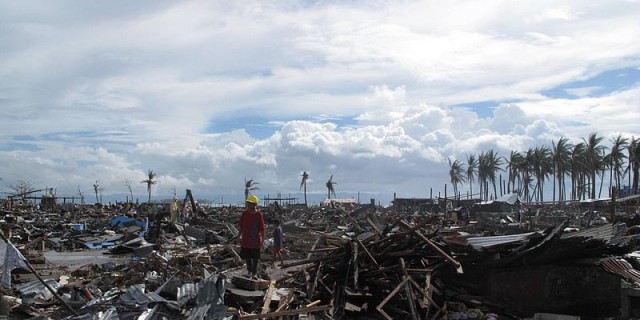
November 7, 2014, by Katharine Adeney
Typhoon Yolanda: One Year Later
Nearly a year ago, on 8 November 2013 super-typhoon Yolanda hit the Visayan region of the Philippines. Winds reached up to 200 mph with a ‘storm surge’ of over 17 feet. The storm surge was actually the height of a tsunami and the damage was catastrophic. The latest available official figures show that 6,293 individuals have been reported dead, 1,061 are missing and 28,689 are injured, vast areas of agricultural land were devastated and whole towns destroyed. The typhoon affected 591 municipalities and the total damage is estimated at US$904,680,000. The total number of people affected by this disaster in terms of livelihood, environmental and food security are approximately 16 million people. However on 6 November 2013, when the potential force of Yolanda was becoming clear, the President of the Philippines, Benigno (Noynoy) Aquino III, declared that government agencies were aiming for zero casualties.
There is little consensus over what the death toll actually is. In order for a death to be recorded a body has to be produced to the authorities. When this author visited the region in July 2014 it was evident that this process was extremely problematic. Local residents reported uncollected bodies lying in the streets and at summary collection points, such as the grounds of Palo Cathedral, for days. Eventually the locals took the matter into their own hands and buried their dead where they could. Meanwhile other victims have never been found. In the days after Yolanda the Eastern Visayas Regional Police Chief, Superintendent Elmer Soria, was apparently sacked for speculating to the media that the eventual death toll would be 10,000. There is every reason to believe that he was actually conservative in his estimate. The true death toll of Yolanda will never be known.
Everyone that I spoke to in Tacloban and the adjacent towns of Palo and Tanauan told the same story. ‘We were used to typhoons but we were not prepared for this’. Many of the deaths were the result of people staying in their homes even in the face of warnings about the typhoon. Adult males were particularly vulnerable as it was routine practice for women and children to find shelter whilst the men stayed behind to guard the house. Even survivors that made it to the evacuation centers found themselves cowering in stairwells as they sought to avoid both rising water and flying debris from above.
Urban risk is a key concern for the Philippines. Globally, of all urban conglomerates with 750,000 inhabitants or more, Metro Manila (pop. 13 million) has been identified as being as being the most at risk from cyclones, floods and earthquakes. 43% of Manila’s population lives in informal housing and the infrastructure of the city is under extreme stress. Sheer weight of numbers coupled with inadequate urban planning mean that traffic is often gridlocked. The city’s drainage system is grossly overburdened and used as a general dumping ground leaving it unable to cope with even ‘normal’ rainfall. The vulnerability of the city has been routinely exposed by typhoons such as Ondoy (2009) and Glenda (2013). The Manila City government has responded by running disaster drills based on a tsunami event similar to the one that struck Japan in 2011. However it is hard to see what Manila’s densely packed shanty population could effectively do in the face of a rapidly approaching tsunami or how the city would cope in the aftermath of such as disaster.
Urban slum dwellers are extremely vulnerable to natural disaster. Housing is flimsy, land may be marginal or exposed and communities are densely populated. Over 40% of the Philippine urban population are slum dwellers. In a Social Weather Stations survey conducted in December 2013 55% of Filipino families considered themselves to be poor. 2013 also saw the population of the Philippines, which has a staunchly Catholic majority, pass the 100 million mark.
Tacloban, which bore the brunt of Yolanda, was a highly vulnerable urbanized area. Since 1990 its population grew by 62% and its housing stock by 74%. Tacloban has a large squatter community. This community was both most at risk from the typhoon and least able to resurrect itself after the disaster. However whilst the sea might be the biggest threat to coastal dwellers it also provides transportation, sustenance and livelihood. This has meant that the 40 meter ‘no dwell zone’ proscribed by the government has been routinely ignored by residents who have little confidence in the government’s ability to roll out alternative livelihood programs. In the face of certain destitution another typhoon is a risk that they are prepared to take.
Sadly this pattern is repeated across other environmentally vulnerable nations and if rapid urbanization is accompanied by poor environmental planning vulnerability will continue to increase in the future. Statistics show that in Laos PDR, Myanmar and Bangladesh more than 75% of the urban population live in slums and at the time of the 2010 earthquake 86% of the population of Port-au-Prince was living in slum conditions. Urban population growth consistency outpaces rural population growth with this trend set to continue.
If rapid urbanization is accompanied by poor environmental planning vulnerability will continue to increase in the future. Poverty is driving vulnerable populations into the path of environmental disasters and this trend looks set to continue. Unchecked this poses fundamental problems for development planning, economic growth and human security.
Pauline Eadie is a University Lecturer at the University of Nottingham. She is Deputy Director of the Institute of Asia Pacific Studies (IAPS) at the University of Nottingham.
Image credit: Wikipedia Commons
No comments yet, fill out a comment to be the first

Leave a Reply